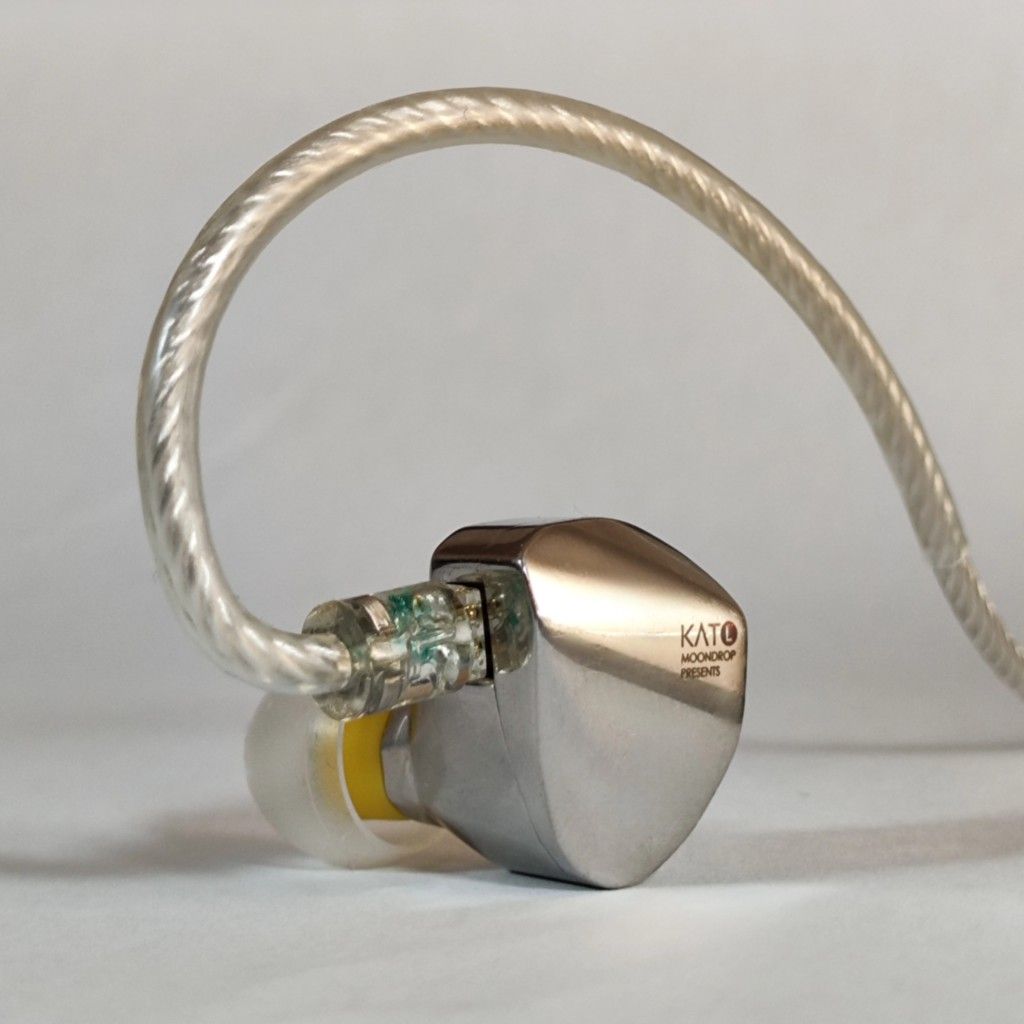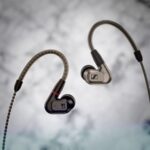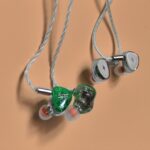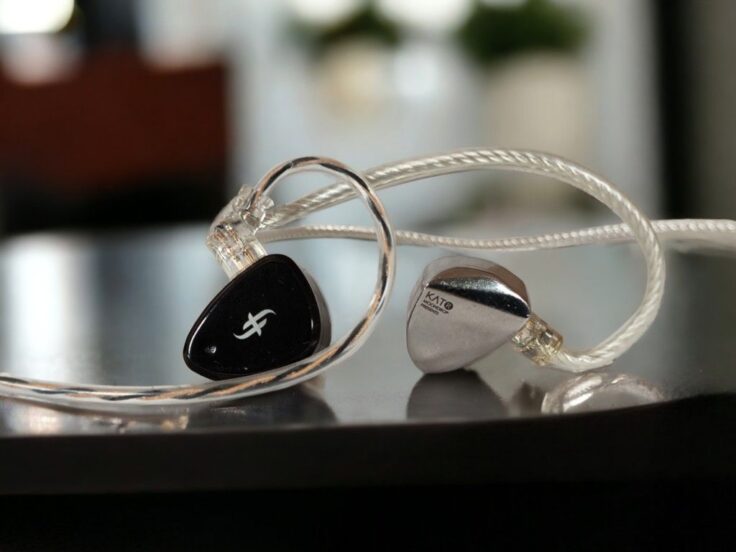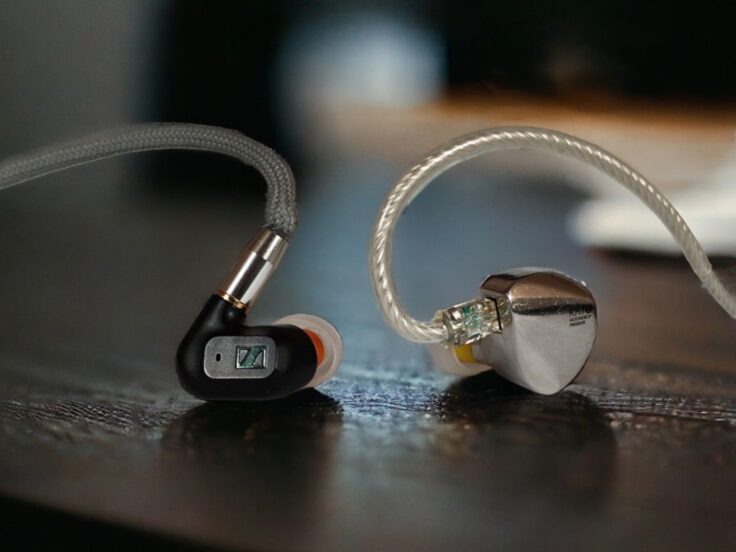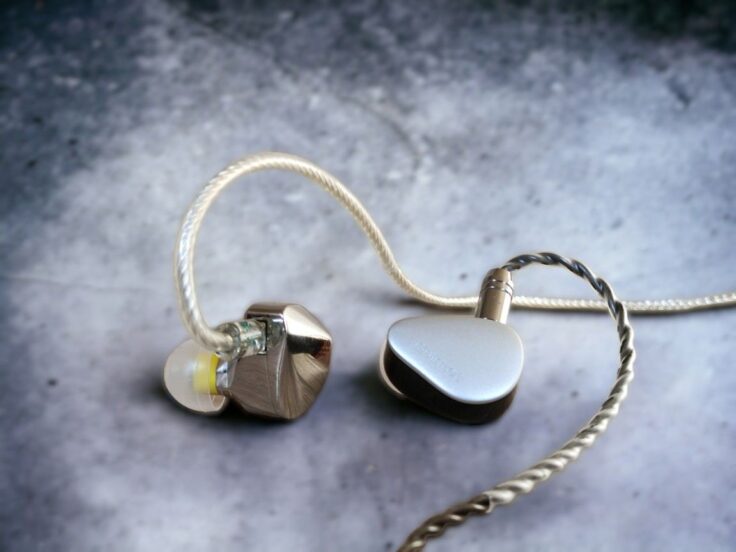The Moondrop Kato has become one of the main references in its price range and for good reasons: It sounds great and it looks beautiful.
Kato’s elegantly designed brass all-metal body houses a single 10mm dynamic driver featuring “ULT” (Ultra Linear Technology). The diaphragm is made of a composite material which includes DLC (Diamond Like Carbon) for increased rigidity and reduced weight.
The Kato features replaceable nozzles and comes with both steel and brass nozzles. They do not sound very different but the brass has a little bit more bass. In this review, however, I will stick to the steel nozzles.
Moondrop’s in-house brand tips, “Spring Tips”, are included and they’re more advanced than the usual supplied ear tips from most manufacturers. According to Moondrop they’re designed to minimize resonance and enhance high-frequency timbre with a special texture. I have nothing against the Spring Tips, but in this review I will stick to my usual SpinFit tips because they fit my ears and I used them with everything. Nothing is more important than getting a good and comfortable seal, and the SpinFits work for me.
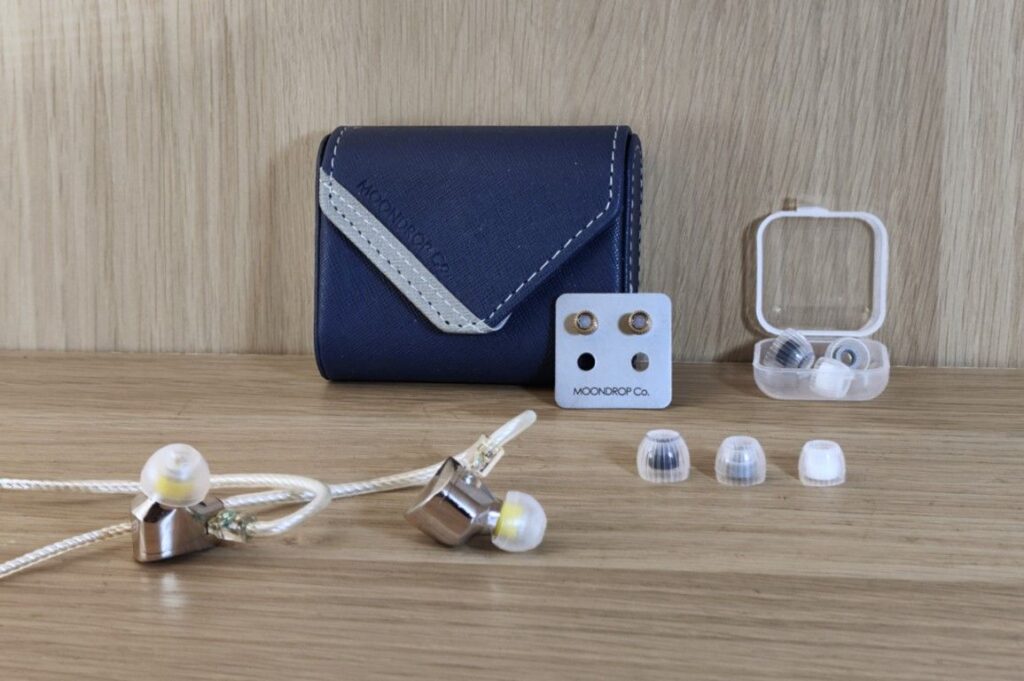
MOONDROP KATO SPECIFICATIONS
- Driver: Single 10mm-ULT dynamic driver
- Diaphragm: 3rd generation DLC composite diaphragm
- Impedance: 32Ω ±15%(@1KHz)
- Sensitivity: 123dB/Nrms (@1KHz)
- Distortion: < 0.15% (@1khz, AES17 20khz, A-weight)
- Socket: 0.78-2 Pin sunken design
- Cable plug: 3.5mm stereo single-ended plug
- Frequency response range: 10Hz-45kHz
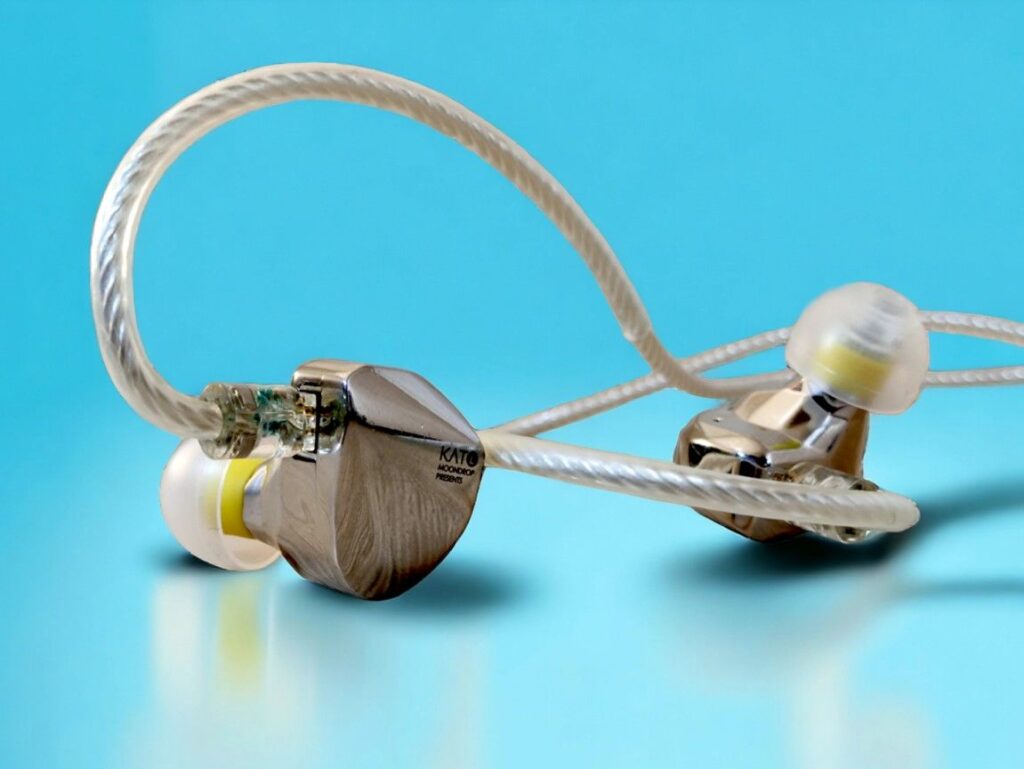
BUILD AND COMFORT
The Moondrop Kato is an all metal construction with replaceable nozzles. It has a simplistic elegance and sits comfortably in the ear. It is very well built and seems to be robust enough to last a very long time. The supplied cable is of very nice quality and I find it to be perfectly balanced between light weight and robust.
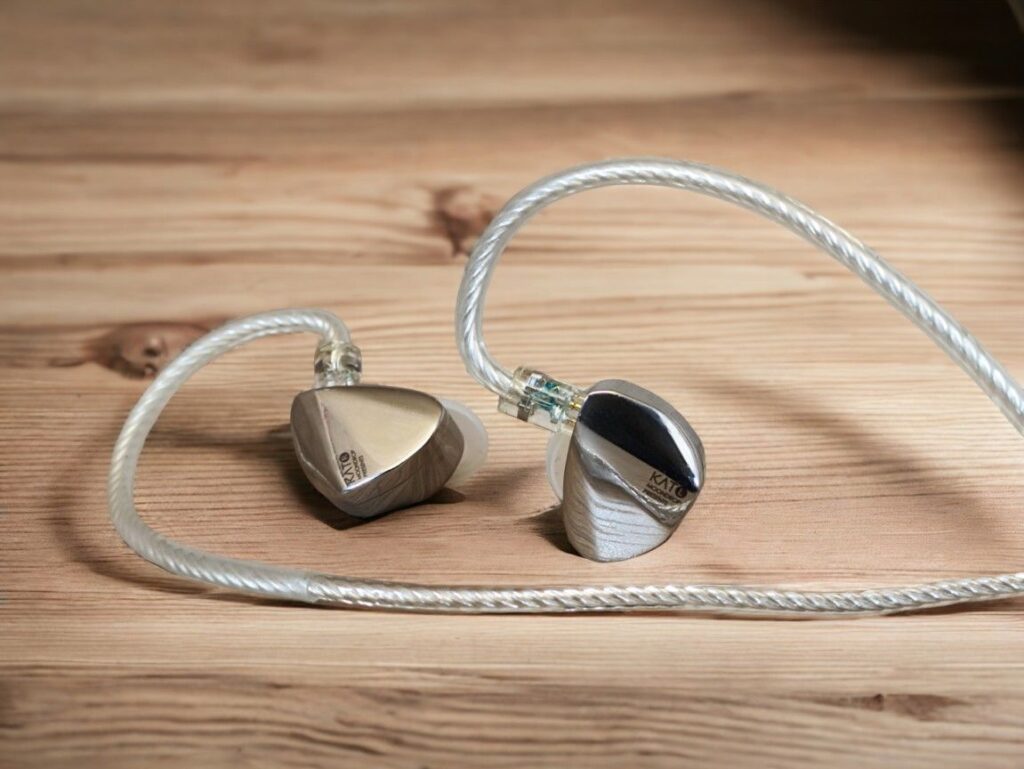
LISTENING IMPRESSIONS
The amplifier used was the Topping A90 desktop amp, the source was the RME ADI-2 DAC FS.
Jambi by Tool
The guitar riff is extremely meaty and full-bodied sounding, yet it has great texture. The vocals have great timbre.
Smile by Pearl Jam
A very nice and coherent presentation. The electric guitars sound wonderful. Eddie Vedder’s vocals sound great, sibilance is not an issue at all. I have heard earphones with better separation but the Kato has a very nice and musical delivery.
Almost Like The Blues by Leonard Cohen
Again it sounds very musical and vocals are delicious. I have heard the bass delivered with a stronger low end, but I find the Kato to be well balanced.
Black Crow by Cassandra Wilson
Everything sounds very natural and organic. Again the vocals have a delicious timbre. This is a very spacious-sounding track and I must admit I have heard it with better separation and more pinpoint imaging, but it does not really matter because as a whole, it sounds very musical and smooth in the right way.
Some Day My Prince Will Come by Coryell-Coryell-Vitous
This track is fantastically delicious to listen to. Everything flows and has great tonal weight and body. The electric guitar is warm and you can hear the tubes inside the guitar amp glowing. The bass is very nice and well-balanced.
Bored by Deftones
Another metal track that sounds absolutely fabulous. The Kato does not have the sharp edges that many earphones can have. This makes so much more music with rough edges enjoyable. The Kato is organic sounding and the music has lots of body, not only sharp textures. The vocal timbre is great, as always.
Mahler Symphony No.2 III by Paavo Järvi
The kettle drums in the opening are full-bodied and just right. The strings sound delicious with a fantastic timbre, the wind and brass instruments sound very natural and organic.
Angel by Massive Attack
The bass is deep and powerful without being too much. It has a great texture but also feels quite meaty. The soundstage is deep with very good imaging. The vocals sound very natura,l as always.
Work Song For a Scattered Past by Fire!
This groovy jazz improv just sounds absolutely terrific. The bass is full and groovy, but not overpowering the rest. The percussion is snappy but not intrusive and Mats Gustafsson’s crazy sax is not too aggressive. Everything is just right.
COMPARISONS
SENNHEISER IE200 VS MOONDROP KATO
Compared to the Kato, IE200 has a more V-shaped sound signature, focusing a bit more on the lower bass and the treble. The Kato has more presence in the mid-bass and midrange, and has a more polite high end.
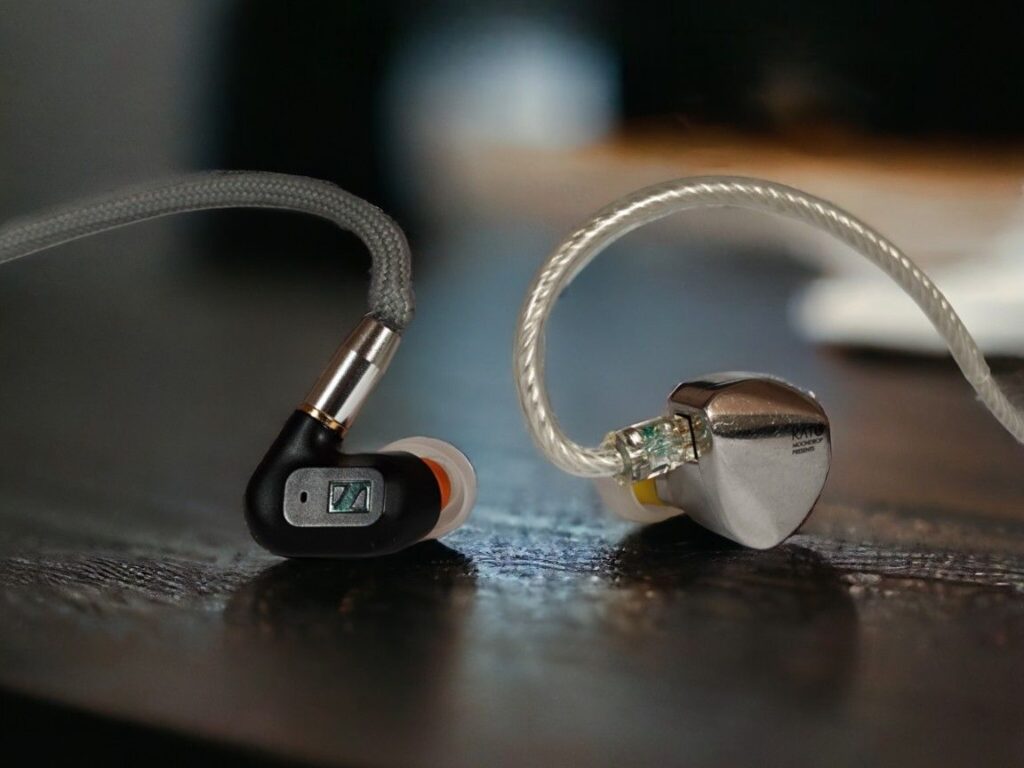
In the treble range, the IE200 is crisper and more articulate, offering more pronounced detail. The Kato, yet still detailed sounding, maintains a smoother, more liquid sound.
The Kato’s mid-range is fabulous. It’s smooth and organic, with a great presence. The IE200’s mid-range is slightly drier but feels a bit clearer and more textured.
With regard to the lower regions, the IE200 is bassier overall, especially in the lowest frequencies. The Kato has more body in the mid-bass which adds fullness and gives a powerful sound.
Both share a relatively wide, tall, and deep soundstage, but the IE200 often excels in imaging due to more space between instruments. Dynamics and detail are strong in both, with the IE200 being more articulate with better microdynamics. The Kato delivers detail in a smoother, liquid fashion.
In absolute terms, the IE200 is smoother sounding than many IEMs, but the Kato stands out as the smoother one in direct comparison.
The IE200 is significantly more demanding on the amplifier than the Kato.
Buy on Amazon: Sennheiser IE200
KIWI EARS QUINTET VS MOONDROP KATO
These two IEMs have many things in common. The general sound signature is very similar. The Quintet has a bit more articulate detail and sounds a bit more transparent. It also has a slightly wider soundstage with better imaging and instrument separation. The bass is tighter and sometimes punchier, the midrange sounds more textured, and the treble is a little bit more pronounced and more detailed.
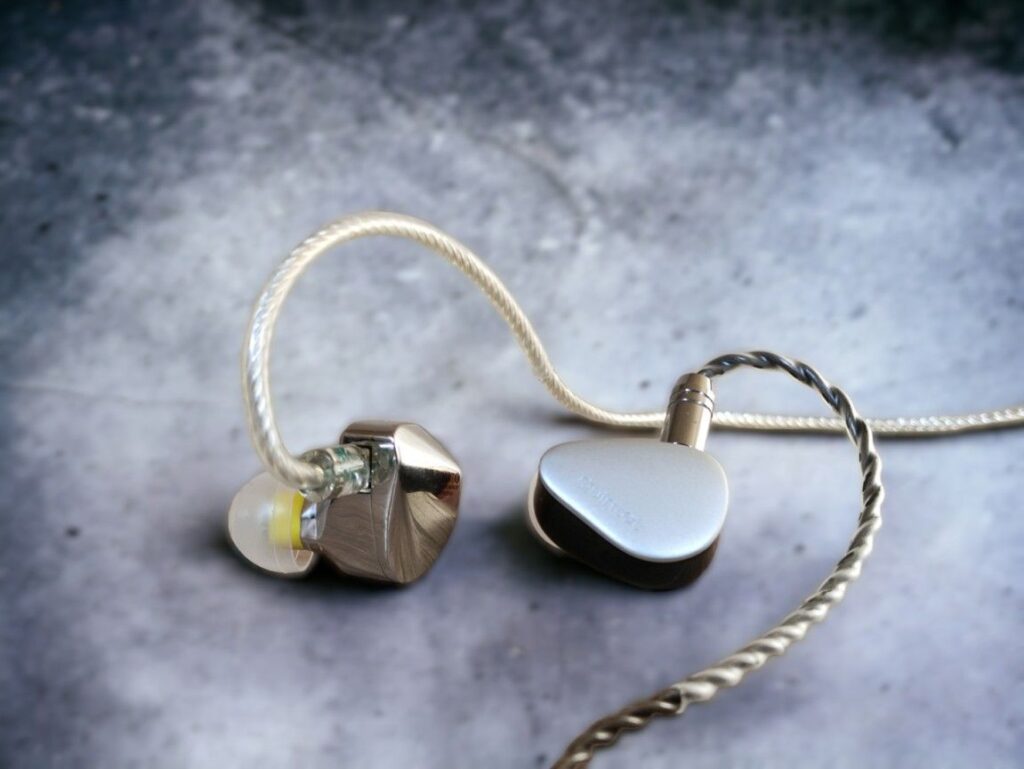
All that being said, the Kato is no slouch in either compartment. What the Kato brings to the table to a larger degree than the Quintet is a smoother, more liquid and organic sound – which is quite enthralling.
The Quintet is equally easy to drive as the Kato with regards to amplification.
Buy on Linsoul: Kiwi Quintet
Buy on Amazon: Kiwi Quintet
KIWI ORCHESTRA LITE VS MOONDROP KATO
In terms of sound signature, the Kato is a bit more U-shaped with a stronger emphasis on the treble and the bass, whilst the Orchestra Lite has less bass and a more pronounced upper midrange.
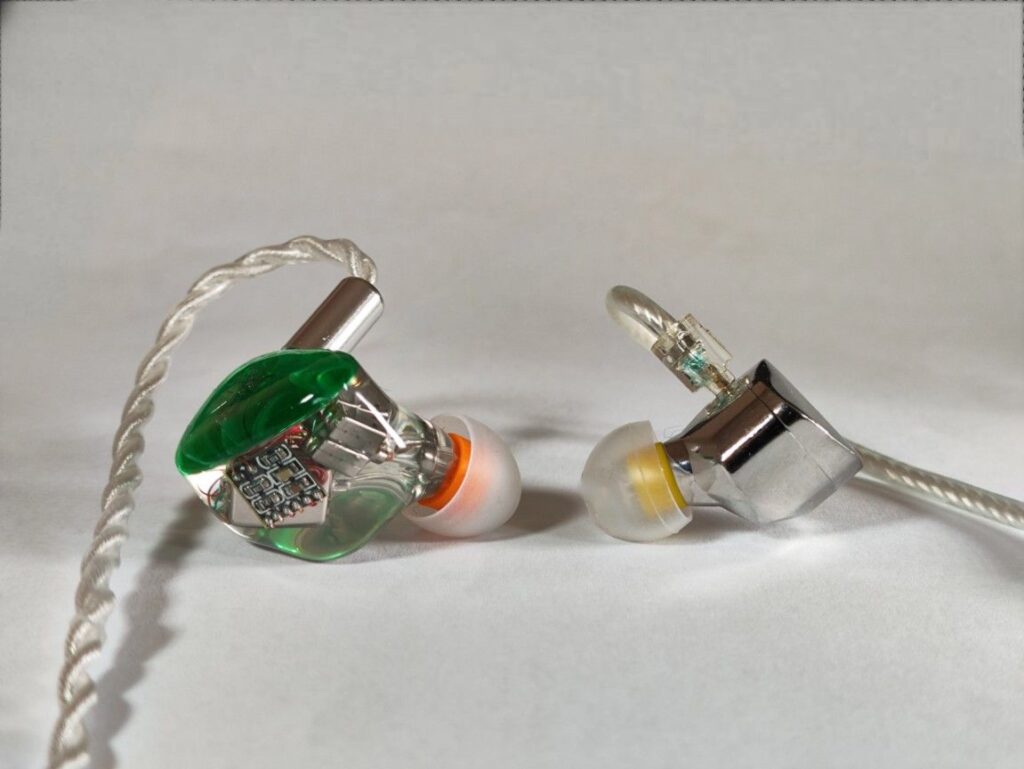
The soundstage is very wide with the Orchestra Lite, the Kato is slightly more intimate. Imaging is similarly good.
The treble is quite pronounced with both. The mid-range, however, is more different. The Orchestra Lite sounds brighter and has more energy in the upper mids. The Kato is warmer and lusher.
The bass is definitely more prominent with the Kato. It has more energy and slam. Sometimes it’s a little more than needed, sometimes the Orchestra Lite feels a bit lacking.
When it comes to details, the Orchestra Lite tends to deliver slightly more. It’s articulate across the frequency spectrum with better microdynamics. The Kato is more subtle and polished. The Orchestra Lite got better macrodynamics in the mids and highs, the Kato excels in the bass.
The Orchestra Lite is at least as equally easy to drive with regards to amplification as the Kato.
Buy on Linsoul: Kiwi Orchestra Lite
Buy on Amazon: Kiwi Orchestra Lite
SIMGOT EM6L VS MOONDROP KATO
The Simgot EM6L and the Moondrop Kato share a similar tuning towards the Harman 2019 target. However, they sound quite different.
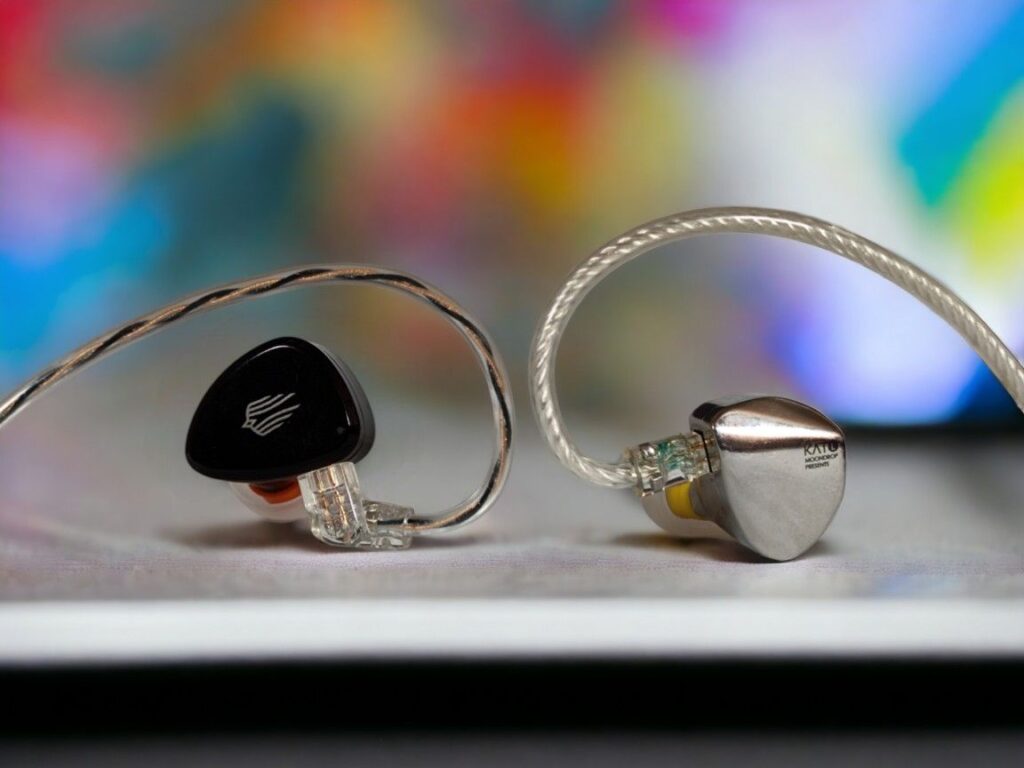
The Kato is generally smoother and at the same time more detailed and refined sounding. It falls short in soundstage size and imaging precision, where the EM6L is simply outstanding. Even though the EM6L has a clear treble, it’s a bit dry sounding – especially when compared to the Kato. It also has a thinner sounding midrange. With warmer sounding amps, though, both the treble and midrange gets fuller and more organic sounding and the presentation gets slightly more similar to the Kato.
The EM6L is more demanding to drive than the Kato, both in terms of power and matching.
Buy on Linsoul: Simgot EM6L
Buy on Amazon: Simgot EM6L
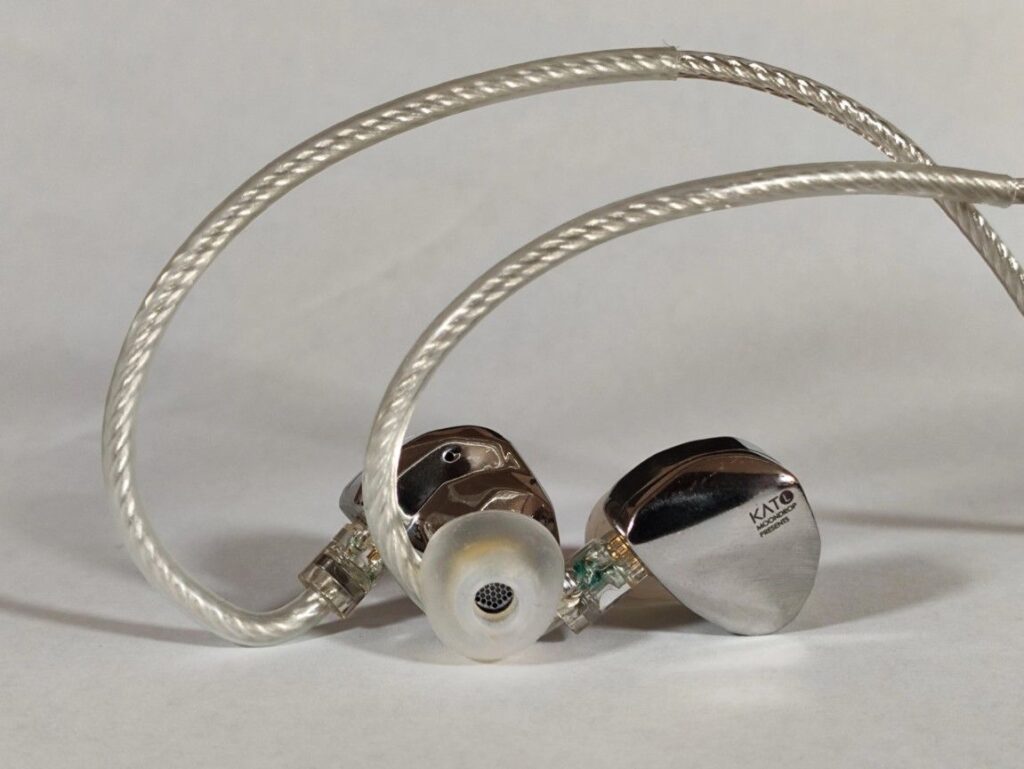
WRAPPING IT UP
Sound Signature
The Kato is a relatively neutral sounding IEM. Neutral in this context does not mean that the frequency response is flat, though. Like most in-ear monitors it is tuned with an eye on the Harman response curve which has an elevated bass and treble. However, I will not call it V-shaped. To me, it sounds very natural and compared to many other IEMs, the mid-bass and midrange get more attention. I really like the Kato’s tuning.
Treble
The treble is smooth and well-rounded. It never gets harsh or too bright. There is plenty of detail but it does not intrude your ears with blatant crispness and offensive clarity. It just sounds very organic.
Midrange
I think the midrange is absolutely fantastic. The timbre of vocals, guitars, strings, pianos, brass and wind instruments are always extremely natural and organic sounding. The Kato’s midrange is detailed in a very effortless and non-intrusive way.
Bass
I think the bass quantity is perfect. It sounds very natural and just right. It has a meaty and organic quality that I really enjoy. There are competitors with more texture and definition in the bass department, but I don’t really feel like I am missing anything.
Soundstage and Imaging
The soundstage is pretty average for a good IEM. It is not small and it is not extraordinarily large. The same goes for the imaging, I have heard earphones with a blacker background and more defined positioning of instruments. However, I will not hold this against the Kato, because what you get instead is a very enveloping and immersive presentation. You do not get the hyper-realism that some earphones, headphones, and especially speakers setups can give you, but you get a natural presentation where things blend a little bit more together.
Detail, Dynamics and Timbre
The Kato has a high detail level, but details are not presented in a hyper-precise manner, rather it is delivered smoothly and organically, in a way that sounds very natural.
Dynamics are also very good but the Kato is dynamic in a natural-sounding way. The dynamic contrast is not extreme, rather it is well balanced and coherent without sounding exaggerated.
Timbre is excellent throughout the entire frequency range. I keep talking about how natural and organic it sounds and that is because the timbre is so right.
AMPLIFICATION
The Moondrop Kato is not especially difficult to drive. It sounds very good from both my old LGV40 and the POCO F5 (2023) phone’s 3.5mm jack with volume at 7/10 with Tool’s Jambi. It’s even better from the THX Onyx USB dongle with volume at 5/10. My desktop rigs are hard to beat but the difference is relatively small compared to the Onyx.
With regards to amplification, I thus consider the Moondrop Kato to be very versatile.
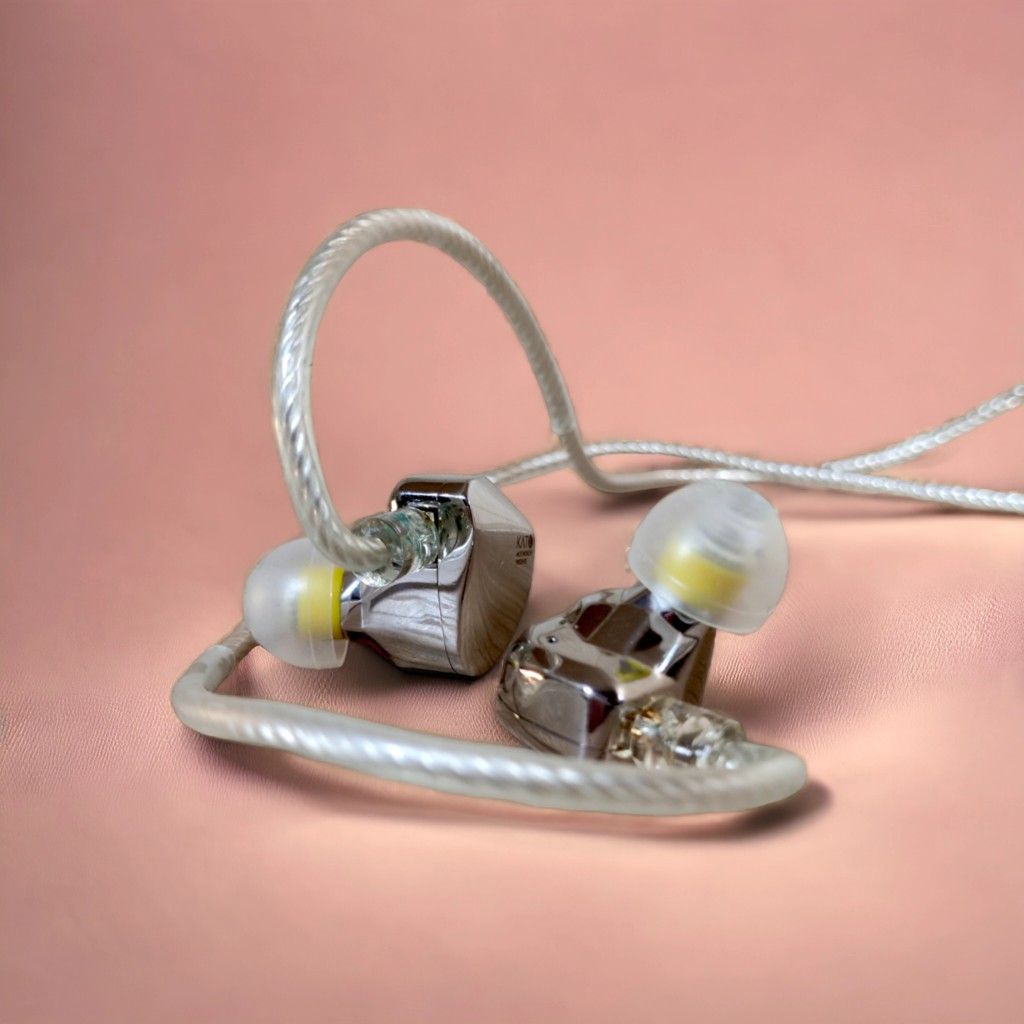
CONCLUSION
In conclusion, the Moondrop Kato offers a relatively neutral yet captivating sound signature, with a focus on mid-bass and midrange. The treble is smooth, the midrange is fantastic, and the bass is just right. Despite an average soundstage and imaging, the Kato provides an enveloping and immersive presentation. Detail, dynamics, and timbre are delivered in a natural and organic manner. The Kato is versatile and easy to drive, and performs well with all amps, dongles and even smartphones I tried. Even though the Moondrop Kato has been on the market for some time, it is still a compelling choice for audio enthusiasts.
Buy on Linsoul: Moondrop Kato
Buy on Amazon: Moondrop Kato
Any purchase you make on Amazon or Linsoul with any of our affiliate links will give us a small provision at no cost to you.
We only get a provision for items that are not returned, so there’s no incentive for us to recommend something that’s not good.
Linsoul : Headphones, Earbuds, Wireless Earbuds, Desktop DAC/AMP, Portable DAC/AMP, Digital Audio Players,
Amazon: Headphones, IEMs, Headphone Amplifiers, Home Audio or Anything else.
.
If you enjoyed this article or other content on The Headphoneer, you might consider leaving a small donation to keep this website up and running. No donation is too small. Thanks for supporting us!
If you like our work please follow us on Instagram, Facebook and Twitter , it will help us grow. Sharing is caring 🙂


